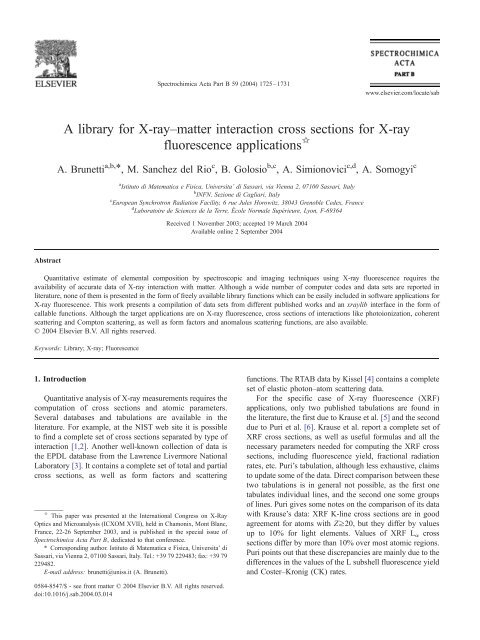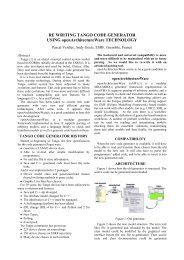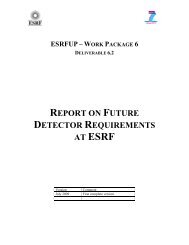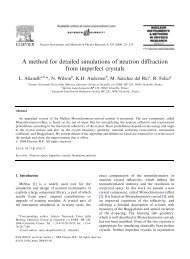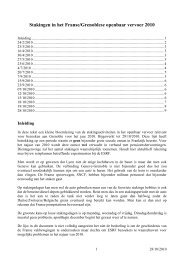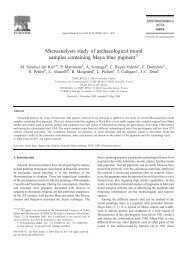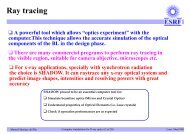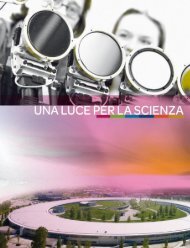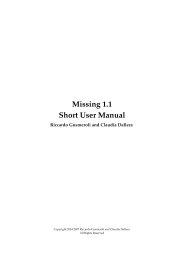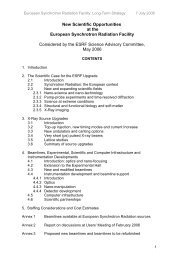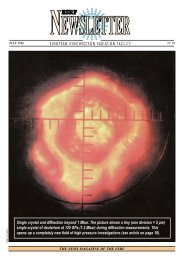A library for X-ray–matter interaction cross sections for X-ray ... - ESRF
A library for X-ray–matter interaction cross sections for X-ray ... - ESRF
A library for X-ray–matter interaction cross sections for X-ray ... - ESRF
Create successful ePaper yourself
Turn your PDF publications into a flip-book with our unique Google optimized e-Paper software.
Abstract<br />
A <strong>library</strong> <strong>for</strong> X-<strong><strong>ray</strong>–matter</strong> <strong>interaction</strong> <strong>cross</strong> <strong>sections</strong> <strong>for</strong> X-<strong>ray</strong><br />
fluorescence applications B<br />
A. Brunetti a,b, *, M. Sanchez del Rio c , B. Golosio b,c , A. Simionovici c,d , A. Somogyi c<br />
a Istituto di Matematica e Fisica, Universita’ di Sassari, via Vienna 2, 07100 Sassari, Italy<br />
b INFN, Sezione di Cagliari, Italy<br />
c European Synchrotron Radiation Facility, 6 rue Jules Horowitz, 38043 Grenoble Cedex, France<br />
d Laboratoire de Sciences de la Terre, École Normale Supérieure, Lyon, F-69364<br />
Received 1 November 2003; accepted 19 March 2004<br />
Available online 2 September 2004<br />
Quantitative estimate of elemental composition by spectroscopic and imaging techniques using X-<strong>ray</strong> fluorescence requires the<br />
availability of accurate data of X-<strong>ray</strong> <strong>interaction</strong> with matter. Although a wide number of computer codes and data sets are reported in<br />
literature, none of them is presented in the <strong>for</strong>m of freely available <strong>library</strong> functions which can be easily included in software applications <strong>for</strong><br />
X-<strong>ray</strong> fluorescence. This work presents a compilation of data sets from different published works and an x<strong>ray</strong>lib interface in the <strong>for</strong>m of<br />
callable functions. Although the target applications are on X-<strong>ray</strong> fluorescence, <strong>cross</strong> <strong>sections</strong> of <strong>interaction</strong>s like photoionization, coherent<br />
scattering and Compton scattering, as well as <strong>for</strong>m factors and anomalous scattering functions, are also available.<br />
D 2004 Elsevier B.V. All rights reserved.<br />
Keywords: Library; X-<strong>ray</strong>; Fluorescence<br />
1. Introduction<br />
Spectrochimica Acta Part B 59 (2004) 1725–1731<br />
Quantitative analysis of X-<strong>ray</strong> measurements requires the<br />
computation of <strong>cross</strong> <strong>sections</strong> and atomic parameters.<br />
Several databases and tabulations are available in the<br />
literature. For example, at the NIST web site it is possible<br />
to find a complete set of <strong>cross</strong> <strong>sections</strong> separated by type of<br />
<strong>interaction</strong> [1,2]. Another well-known collection of data is<br />
the EPDL database from the Lawrence Livermore National<br />
Laboratory [3]. It contains a complete set of total and partial<br />
<strong>cross</strong> <strong>sections</strong>, as well as <strong>for</strong>m factors and scattering<br />
B This paper was presented at the International Congress on X-Ray<br />
Optics and Microanalysis (ICXOM XVII), held in Chamonix, Mont Blanc,<br />
France, 22-26 September 2003, and is published in the special issue of<br />
Spectrochimica Acta Part B, dedicated to that conference.<br />
* Corresponding author. Istituto di Matematica e Fisica, Universita’ di<br />
Sassari, via Vienna 2, 07100 Sassari, Italy. Tel.: +39 79 229483; fax: +39 79<br />
229482.<br />
E-mail address: brunetti@uniss.it (A. Brunetti).<br />
0584-8547/$ - see front matter D 2004 Elsevier B.V. All rights reserved.<br />
doi:10.1016/j.sab.2004.03.014<br />
www.elsevier.com/locate/sab<br />
functions. The RTAB data by Kissel [4] contains a complete<br />
set of elastic photon–atom scattering data.<br />
For the specific case of X-<strong>ray</strong> fluorescence (XRF)<br />
applications, only two published tabulations are found in<br />
the literature, the first due to Krause et al. [5] and the second<br />
due to Puri et al. [6]. Krause et al. report a complete set of<br />
XRF <strong>cross</strong> <strong>sections</strong>, as well as useful <strong>for</strong>mulas and all the<br />
necessary parameters needed <strong>for</strong> computing the XRF <strong>cross</strong><br />
<strong>sections</strong>, including fluorescence yield, fractional radiation<br />
rates, etc. Puri’s tabulation, although less exhaustive, claims<br />
to update some of the data. Direct comparison between these<br />
two tabulations is in general not possible, as the first one<br />
tabulates individual lines, and the second one some groups<br />
of lines. Puri gives some notes on the comparison of its data<br />
with Krause’s data: XRF K-line <strong>cross</strong> <strong>sections</strong> are in good<br />
agreement <strong>for</strong> atoms with Zz20, but they differ by values<br />
up to 10% <strong>for</strong> light elements. Values of XRF La <strong>cross</strong><br />
<strong>sections</strong> differ by more than 10% over most atomic regions.<br />
Puri points out that these discrepancies are mainly due to the<br />
differences in the values of the L subshell fluorescence yield<br />
and Coster–Kronig (CK) rates.
1726<br />
Table 1<br />
Names, input and output of the x<strong>ray</strong>lib functions<br />
Category Function Returns<br />
Atomic data float AtomicWeight(int Z) atomic weight<br />
Cross <strong>sections</strong>:<br />
(cm 2 /g)<br />
Cross <strong>sections</strong>:<br />
(barn/atom)<br />
Differential<br />
unpolarized<br />
<strong>cross</strong> <strong>sections</strong>:<br />
(cm 2 /g/sterad)<br />
Differential<br />
unpolarized<br />
<strong>cross</strong> <strong>sections</strong>:<br />
(barns/atom/<br />
sterad)<br />
Form factors,<br />
scattering<br />
functions,<br />
momentum<br />
transfer<br />
float CS_Total(int Z, float E) Total <strong>cross</strong> section<br />
(photoionization+<br />
Rayleigh+<br />
Compton)<br />
float CS_Photo(int Z, float E) Photoionization<br />
CS<br />
float CS_Rayl(int Z, float E) Rayleigh CS<br />
float CS_Compt(int Z, float E) Compton CS<br />
float CS_FluorLine(int Z, int XRF CS<br />
line, float E)<br />
float CS_KN(float E) Klein-Nishina CS<br />
float CSb_Total(int Z, float E) Total <strong>cross</strong> section<br />
(photoionization+<br />
Rayleigh+<br />
Compton)<br />
float CSb_Photo(int Z, Photoionization<br />
float E)<br />
CS<br />
float CSb_Rayl(int Z, float E) Rayleigh CS<br />
float CSb_Compt(int Z, Compton CS<br />
float E)<br />
float CSb_FluorLine(int Z, int XRF CS<br />
line, float E)<br />
float DCS_Rayl(int Z, float E, Rayleigh DCS<br />
float theta)<br />
float DCS_Compt(int Z, Compton DCS<br />
float E, float theta)<br />
float DCS_Thoms(float Thomson DCS<br />
theta)<br />
float DCS_KN(float E, Klein–Nishina<br />
float theta)<br />
DCS<br />
float DCSb_Rayl(int Z, Rayleigh DCS<br />
float E, float theta)<br />
float DCSb_Compt(int Z, Compton DCS<br />
float E, float theta)<br />
float FF_Rayl(int Z, float q) Rayleigh<br />
float SF_Compt(int Z, float q) Incoherent<br />
scattering function<br />
float MomentTransf(float E, Momentum<br />
float theta)<br />
transfer (A^-1)<br />
Compton energy float ComptonEnergy(float E0,<br />
float theta)<br />
Absorption edges<br />
and transitions<br />
data<br />
Photon energy<br />
after Compton<br />
scattering<br />
Absorption edge<br />
energy [keV]<br />
Fluorescence line<br />
energy [keV]<br />
Fluorescence yield<br />
float EdgeEnergy(int Z, int<br />
shell)<br />
float LineEnergy(int Z,<br />
int line)<br />
float FluorYield(int Z,<br />
int shell)<br />
float JumpFactor(int Z, Jump ratio<br />
int shell)<br />
float RadRate(int Z, int line) Radiation rate<br />
float CosKronTransProb(int Z, Coster–Kronig<br />
int trans)<br />
transition<br />
probability<br />
It is possible to directly use the data from these<br />
tabulations <strong>for</strong> software applications. Both data sets come<br />
in a paper <strong>for</strong>mat, but it is possible to transcribe the data into<br />
electronic <strong>for</strong>mat. However, this is a very rigid approach,<br />
because it is not possible to verify and upgrade the data<br />
contributing to the fluorescence <strong>cross</strong> section, to get<br />
A. Brunetti et al. / Spectrochimica Acta Part B 59 (2004) 1725–1731<br />
accurate interpolated data (as the energy step <strong>for</strong> the<br />
tabulations is usually quite large), and use fluorescence<br />
lines other than the tabulated. Moreover, these references are<br />
quite old and although there is no new published compilation<br />
of XRF <strong>cross</strong> <strong>sections</strong>, there was in the last years<br />
remarkable progress in evaluated data, in particular <strong>for</strong><br />
photoionization <strong>cross</strong> section and anomalous scattering<br />
factors [2–4,7], and fluorescence yields [8]. It is there<strong>for</strong>e<br />
interesting to benefit from these new and more accurate data<br />
<strong>for</strong> the calculations of the XRF <strong>cross</strong> section. Thus, our<br />
approach is to evaluate XRF from its components, and not<br />
using published tables of XRF <strong>cross</strong> <strong>sections</strong>.<br />
An attempt to solve the problem of interfacing the data<br />
to the user is reported by Elam et al. [9]. They used a<br />
selection of previously published data. Although we found<br />
this tabulation extremely useful, we found difficulties in<br />
using it <strong>for</strong> XRF purposes. We present here a new database,<br />
which is loaded by a software package based on a shared C<br />
language <strong>library</strong>. Our interface functions are easily<br />
imported into languages used in scientific programming<br />
like C, Fortran and Python, and run in most operating<br />
systems. XRF data produced by our <strong>library</strong> are compared<br />
Krause data [5] and the differences are discussed. This<br />
<strong>library</strong> has been shown to be a valuable tool <strong>for</strong> several<br />
applications we developed that require a quick access to<br />
data, like fast spectroscopy reconstructions and Monte<br />
Carlo simulations.<br />
Fig. 1. Relative differences between the XRF <strong>cross</strong> <strong>sections</strong> (or partial<br />
photoionization <strong>cross</strong> section) using the full partial <strong>cross</strong> section tabulation<br />
(Scofield) and the jump approximation (in x<strong>ray</strong>lib), <strong>for</strong> Z=13 (top) and<br />
Z=80 (bottom).
2. The x<strong>ray</strong>lib function interface<br />
In quantitative analysis of X-<strong>ray</strong> fluorescence, one needs<br />
to access different X-<strong>ray</strong> data in a quick way. For example,<br />
when analysing an XRF spectrum, the different lines<br />
corresponding to the trace elements can be analysed<br />
separately. In first approximation (thick target, primary<br />
fluorescence), the X-<strong>ray</strong> intensity at the detector can be<br />
written as [10]<br />
Iel ¼ Io<br />
X rXRFðE0Þ<br />
4p rTOTðE0Þ<br />
1<br />
sinw 1<br />
Cel~elðE0Þ<br />
~ðE0Þ<br />
sinw 1<br />
þ ~ðElÞ<br />
sinw 2<br />
ð1Þ<br />
where Il is the XRF intensity <strong>for</strong> a trace element belQ of weight<br />
concentration Cel, I0 is the incident photon intensity at energy<br />
E 0, X is the detector solid angle, r XRF and r PE are the<br />
fluorescence and photoionization <strong>cross</strong> <strong>sections</strong>, respectively,<br />
w1 (w2) is the incident (take off) angle measured with respect<br />
3. XRF <strong>cross</strong>-section calculations<br />
For the calculation of the XRF <strong>cross</strong> <strong>sections</strong>, the following <strong>for</strong>mulas are used [5]<br />
rKaKb ¼ rKðEÞxKFKaKb rL1j ¼ rL1 x1FL1j<br />
to the sample surface, and ~ el and ~ are the attenuation<br />
coefficients of the trace element and matrix, respectively.<br />
In order to evaluate this equation, it is necessary to<br />
calculate different <strong>cross</strong> <strong>sections</strong> and attenuation coefficients<br />
<strong>for</strong> the matrix and trace element considered at two energies,<br />
the incident photon energy and the energy of the considered<br />
line. In x<strong>ray</strong>lib, we provide functions that can calculate each<br />
of these ingredients in a single line of code. The names of<br />
the functions are in Table 1.<br />
The function interface, written in ANSI C, can be linked<br />
with any program written in C, C+ or Fortran. Moreover, the<br />
x<strong>ray</strong>lib <strong>library</strong> can be bound to software in different<br />
programming languages, provided that a C linking is<br />
available. The x<strong>ray</strong>lib <strong>library</strong> has been tested in Macintosh<br />
OSX, Linux and Microsoft Windows operating systems. It<br />
has also been bound to the two high-level shell languages<br />
IDL and Python. It is also possible to access the database<br />
just as a bpocket calculatorQ, i.e., by using a set of command<br />
line instructions, developed in a Python shell script.<br />
where rk is the K-shell <strong>cross</strong> section; xk is the K-shell fluorescence yield; F is the fractional emission rate ( Fka,h=Ika+Ikb); j<br />
are the transitions ending in L1. Krause gives values <strong>for</strong> the transitions L1L23, L1M3 (Lh3) and L1O23 (Lg4),<br />
rL2j ¼ rL2 x2FL2j þ rL1 x2FL2jf1;2<br />
where now j are the transitions ending in L 2 and the f are the Coster–Kronig yields. In Krause there are: L 2M 4 (Lh 1) and L 2N 4<br />
(Lg 1), and<br />
rL3j ¼ rL3 x3FL3j þ rL2 x3FL3jf2;3 þ rL1 x3FL3j f1;3 þ f1;3V þ f1;2f2;3<br />
here j are the transitions ending in L3: <strong>for</strong> L3M5 (La1), L3N45 (Lh2,15), L3M1 (Ll)<br />
These expressions need the partial (<strong>for</strong> K, L 1,L 2 and L 3) photoionization <strong>cross</strong> <strong>sections</strong> as a function of the photon energy.<br />
Commonly used tabulations are those of Scofield [11], EPDL [3] and Kissel [4]. As the storage and access of these data is<br />
cumbersome, it is in many cases useful to store the so-called bjumping ratioQ, or the ratio between the photoionization <strong>cross</strong><br />
section after the edge (typically 1 eV after the edge) divided by the value be<strong>for</strong>e the edge. For example, <strong>for</strong> the K-edge:<br />
JKðEÞ ¼ rafter<br />
rbe<strong>for</strong>e<br />
¼<br />
rT<br />
rT rK<br />
This jumping ratio, by definition, depends only on the atomic element and shell, and it is not a function of the energy;<br />
there<strong>for</strong>e, its storage and access is lighter. We can write the partial <strong>cross</strong> <strong>sections</strong> approximately as:<br />
rKðEÞ ¼ rPEðEÞs0; rL ðEÞ ¼ rPEðEÞs ð3;2;1Þ ð3;2;1Þ ð7Þ<br />
and the s values taken are<br />
s0 ¼ JK 1<br />
and<br />
JK<br />
A. Brunetti et al. / Spectrochimica Acta Part B 59 (2004) 1725–1731 1727<br />
EbEL3 EL3bEbEL2 EL2bEbEL1 EL1bEbEK EKbE<br />
s1 0 0 0 (JL1 1)/JL1 ( JL1 1)/( JKJL1)<br />
s2 0 0 (JL2 1)/JL2 (JL2 1)/(JL1JL2) (JL2 1)/( JKJ L1JL2) s3 0 (JL3 1)/JL3 ( JL3 1)/( JL2JL3) (JL3 1)/(JL1JL2JL3) (JL3 1)/( JKJ L1JL2JL3) ð2Þ<br />
ð3Þ<br />
ð4Þ<br />
ð5Þ<br />
ð6Þ<br />
ð8Þ
1728<br />
It is clear that use of jump ratios gives correct result only in the case that the incident photons have energies slightly higher than<br />
the edge of the selected element. This is not the case of standard XRF, where the energy of the incident photons is set several<br />
kiloelectron volts higher than the energy if the highest line. We have calculated the differences of the XRF <strong>cross</strong> <strong>sections</strong> using<br />
the jump approximation (x<strong>ray</strong>lib version 2.3) and the Scofield’s partial <strong>cross</strong> <strong>sections</strong> (Fig. 1). We see errors of few percent due<br />
to this approximation <strong>for</strong> the K lines. For the L lines the differences are much more important. In Table 2 we can see the<br />
example of Ca. At energies where si depends only on JLi, we have errors of the order of 50% <strong>for</strong> L3 lines, 20% <strong>for</strong> L2 and more<br />
than 400% <strong>for</strong> L1. After many numerical comparisons with Krause tabulations, we concluded that the jump approximation can<br />
be safety used <strong>for</strong> K lines, should be used with care <strong>for</strong> L3 and L2, and should never be used <strong>for</strong> L1 lines. XRF <strong>cross</strong> <strong>sections</strong><br />
given by x<strong>ray</strong>lib 2.3 (using the jump approximation) are compared with Krause data in the bx<strong>ray</strong>lib tablesQ, an electronic<br />
document available with the x<strong>ray</strong>lib distribution. As a result of this study, we decided to implement the full partial <strong>cross</strong><br />
<strong>sections</strong> that will be available in next version of x<strong>ray</strong>lib.<br />
Important discrepancies in calculated XRF <strong>cross</strong> <strong>sections</strong> are found depending on the used values of fluorescence yield and<br />
fractional radiative rates. As there is a linear dependence of the XRF on these parameters, they are discussed in the next<br />
section. Plots of the XRF fluorescence <strong>cross</strong> <strong>sections</strong> calculated by x<strong>ray</strong>lib are shown in Fig. 2.<br />
4. The x<strong>ray</strong>lib database: <strong>cross</strong> <strong>sections</strong> and other X-<strong>ray</strong><br />
functions<br />
The x<strong>ray</strong>lib functions are the user interface <strong>for</strong><br />
internally stored data. These data files are not supposed<br />
to be modified or accessed by the user. However, we have<br />
Table 2<br />
Input and output variable description<br />
Meaning Name Values/Unit<br />
Atomic number Z 1–100<br />
Energy E keV<br />
Scattering polar angle theta rad<br />
Scattering azimuthal angle phi rad<br />
Momentum transfer q<br />
Atomic electron shell shell K_SHELL 0<br />
L1_SHELL 1<br />
L2_SHELL 2<br />
L3_SHELL 3<br />
M1_SHELL 4<br />
M2_SHELL 5<br />
M3_SHELL 6<br />
M4_SHELL 7<br />
M5_SHELL 8<br />
Fluorescence Line line KA_LINE 0 (Ka1+Ka2)<br />
KB_LINE 1 (Kh1+Kh3) KL3_LINE 3(Ka1) KL2_LINE 2(Ka2)<br />
KM3_LINE 6(Kh1)<br />
KM2_LINE 5(Kh3) LA_LINE 2<br />
(La1)(or L3M5_LINE<br />
LB_LINE 3<br />
42)<br />
(Lh1)(or L2M4_LINE 29)<br />
L3M1_LINE 38 (Ll)<br />
CK transition probability trans<br />
L2N4_LINE<br />
L1M3_LINE<br />
F1_TRANS 0<br />
F12_TRANS 1<br />
F13_TRANS 2<br />
34 (Lg1)<br />
16 (Lh3) FP13_TRANS 3<br />
F23_TRANS 4<br />
Only the lines of which XRF <strong>cross</strong> section can be calculated with x<strong>ray</strong>lib<br />
are displayed.<br />
A. Brunetti et al. / Spectrochimica Acta Part B 59 (2004) 1725–1731<br />
chosen to use only ASCI data files in order to be easily<br />
human-readable and to be able, if necessary, to access and<br />
modify them.<br />
4.1. Cross section data (Compton, Rayleigh and<br />
photoionization)<br />
Data sets of <strong>cross</strong> <strong>sections</strong> of different mechanisms of<br />
<strong>interaction</strong> atom–photons are given: Compton, Rayleigh and<br />
photoionization. In the current version (x<strong>ray</strong>lib 2.3), these<br />
tabulations are those of Elam et al. [9 and references<br />
therein]. In order to obtain numerical values of <strong>cross</strong><br />
<strong>sections</strong> <strong>for</strong> an arbitrary energy, a cubic spline interpolation<br />
of the logarithm of the <strong>cross</strong> section versus the logarithm of<br />
the energy [12] has been implemented. This approach is the<br />
one also used in Ref. [13]. However, the type of<br />
implementation of the cubic spline is different. In our case,<br />
we used the routine <strong>for</strong> cubic spline interpolation from Ref.<br />
[12], the same routine used by Elam et al. This routine<br />
comes as a set of three values <strong>for</strong> each energy, where the<br />
third value is the second derivative value. The latter value<br />
allows one to control the behaviour of the interpolation at<br />
the edges where a second derivative value of zero is used. In<br />
this way, the sharp transitions at absorption edges can be<br />
managed and only one tabulation can be used. The<br />
photoionization <strong>cross</strong> <strong>sections</strong> given by Elam et al. contain,<br />
<strong>for</strong> energy higher than 1 keV, the <strong>cross</strong> <strong>sections</strong> tabulated by<br />
Hubbell [13] and <strong>for</strong> energy lower than 1 keV the tables<br />
from Plechaty et al. [14]. The <strong>cross</strong> section values at the<br />
absorption edges are given by two values, one just below the<br />
edge and the other just above the edge, both having the<br />
same energy value but not giving any problems with the<br />
interpolation.<br />
The CS_FluorLine function allows calculating the XRF<br />
<strong>cross</strong> <strong>sections</strong>, and this function makes use of the partial<br />
photoionization <strong>cross</strong> <strong>sections</strong> (calculated via the jumping<br />
ratio, as previously described), fluorescence yields and<br />
fractional emission rates of the lines considered. It is also<br />
possible to obtain an averaged photoionization <strong>cross</strong> section<br />
<strong>for</strong> the K lines, avoiding the division in sub lines. This is
useful in the case when the detector used cannot resolve all<br />
the lines of the individual transitions finishing in a given<br />
shell.<br />
We are currently changing the photoionization tabulations<br />
in order to include partial shell <strong>cross</strong> <strong>sections</strong>. These<br />
data are available in Scofield’s and Kissel’s data sets as well<br />
as the EPDL database. The use of partial <strong>cross</strong> <strong>sections</strong><br />
improves the values of the XRF <strong>cross</strong> <strong>sections</strong> by 2–10% <strong>for</strong><br />
the K lines, as discussed be<strong>for</strong>e, and is even more important<br />
<strong>for</strong> the L lines.<br />
4.2. Jump ratio, fluorescence yield, Coster–Kronig<br />
transition probabilities, relative radiative rates<br />
Jump ratios are those tabulated by Elam et al. [9].<br />
Coster–Kronig and radiative rates are taken from Krause<br />
et al. [5]. Fluorescence yields are from Table 4 of<br />
Hubbell et al. [8]. As XRF <strong>cross</strong> <strong>sections</strong> depend linearly<br />
on the fluorescence yields and on the radiative rates, the<br />
errors in these values propagate directly to the XRF <strong>cross</strong><br />
<strong>sections</strong>.<br />
A. Brunetti et al. / Spectrochimica Acta Part B 59 (2004) 1725–1731 1729<br />
Fig. 2. Plots of the XRF <strong>cross</strong> <strong>sections</strong> <strong>for</strong> Ka (KL3+KL2) (top left), Kh (KM2+KM3) (top right), La1 (L3M3) (bottom left) and Lh1 (L2M4) (bottom right).<br />
The parameter on the curves is the atomic number.<br />
Let us take, <strong>for</strong> example, the K-shell fluorescence yield<br />
of Al (Z=11): Hubbell et al. [8] in Table 3 give 0.033 as an<br />
baveragedQ value (used in x<strong>ray</strong>lib). However, Krause’s<br />
[15,5] value is 0.039 and his bcondensed matterQ value is<br />
0.036. The value chosen by Elam et al. [9] is 0.033. These<br />
differences, affecting the XRF <strong>cross</strong> <strong>sections</strong>, may be as<br />
high as 20%.<br />
It is then desirable to use the most accurate values<br />
available, although the choice is not simple.<br />
4.3. Differential scattering <strong>cross</strong> <strong>sections</strong><br />
The differential <strong>cross</strong> <strong>sections</strong> calculated by x<strong>ray</strong>lib use<br />
the following equations.<br />
Differential Thomson <strong>cross</strong> section:<br />
drTðÞ h<br />
dX ¼ r2 e<br />
2 1 þ cos2h ð9Þ<br />
where h is the scattering angle and r e is the classical radius<br />
of the electron.
1730<br />
Table 3<br />
Values of s calculated using the jump approximation and Scofield [11] data<br />
(made available by Kissel [4]) <strong>for</strong> Ca (Z=20)<br />
Edge Energy [keV] Hx (x<strong>ray</strong>lib) Hs (Scofield) Hs/ Hx<br />
K 14.701 0.886 0.906 1.024<br />
K 36.025 0.886 0.909 1.027<br />
K 57.350 0.886 0.910 1.028<br />
K 78.675 0.886 0.910 1.028<br />
K 100.000 0.886 0.910 1.028<br />
L1 0.838 0.105 0.223 2.128<br />
L1 1.638 0.105 0.313 2.991<br />
L1 2.438 0.105 0.380 3.630<br />
L1 3.238 0.105 0.455 4.347<br />
L1 4.038 0.105 0.068 0.648<br />
L2 0.360 0.286 0.234 0.819<br />
L2 0.379 0.286 0.234 0.818<br />
L2 0.399 0.286 0.234 0.818<br />
L2 0.418 0.286 0.234 0.818<br />
L2 0.438 0.286 0.233 0.817<br />
L3 0.347 0.828 0.458 0.553<br />
L3 0.347 0.828 0.458 0.553<br />
L3 0.348 0.828 0.458 0.553<br />
L3 0.349 0.828 0.458 0.553<br />
L3 0.350 0.828 0.458 0.553<br />
L3 0.350 0.828 0.458 0.553<br />
Differential Klein–Nishina <strong>cross</strong> section:<br />
drK Nðh; EÞ<br />
dX<br />
where<br />
K0<br />
K<br />
¼ r2 e<br />
2<br />
K<br />
K0<br />
2 K<br />
K0<br />
þ K0<br />
K<br />
sin 2 h ð10Þ<br />
Ei<br />
¼ 1 þ ð1coshÞ ð11Þ<br />
mec2 Differential Rayleigh <strong>cross</strong> section:<br />
drRðhÞ dX ¼ drTðhÞ dX F2ðx; ZÞ<br />
¼ r2 e<br />
2 1 þ cos2h Fx; ð ZÞ<br />
ð12Þ<br />
Differential Compton <strong>cross</strong> section:<br />
drCðh; EÞ<br />
¼<br />
dX<br />
drK Nðh; EÞ<br />
Sx; ð ZÞ<br />
dX<br />
¼ r2 e<br />
2<br />
K<br />
K0<br />
2 K<br />
K0<br />
þ K0<br />
K<br />
sin 2 h Sx; ð ZÞ<br />
ð13Þ<br />
It also possible to evaluate the polarization-dependent<br />
values of these <strong>cross</strong> <strong>sections</strong>.<br />
4.4. Form factor and scattering function<br />
The <strong>for</strong>m factor and scattering function come from the<br />
Hubbell [13] and Cullen et al. [3] compilations. The <strong>for</strong>ms<br />
factors are the non-relativistic data calculated by Hubbell.<br />
He also calculated the relativistic and relativistic modified<br />
<strong>for</strong>m factors. However, he recommended to use the nonrelativistic<br />
data because they are closer to the experimental<br />
data. The anomalous scattering functions are due to Cullen<br />
et al. [3] who evaluated them from photoionization <strong>cross</strong><br />
<strong>sections</strong> using the relativistic dispersion relation.<br />
A. Brunetti et al. / Spectrochimica Acta Part B 59 (2004) 1725–1731<br />
4.5. Atomic parameters<br />
The edge energies are from the tabulation by Larskin [16]<br />
reported in Ref. [17]. The energies of the fluorescence lines<br />
are the experimental values of Deslattes et al. [18]. Whenever<br />
the experimental value is missing, the theoretical one from<br />
the same reference is used. Moreover, we used <strong>for</strong> the Ka1 <strong>for</strong><br />
Z=3–9, absent in the reference, the values from Ref. [19].<br />
5. Conclusions and perspectives<br />
A new database, with a user interface in the <strong>for</strong>m of a C<br />
callable <strong>library</strong>, has been developed <strong>for</strong> XRF and other X<strong>ray</strong><br />
applications. The <strong>library</strong> has been tested <strong>for</strong> the last 6<br />
months at both the <strong>ESRF</strong> and at the Institute of Mathematics<br />
and Physics of the University of Sassari <strong>for</strong> Monte Carlo<br />
simulations and other on-line applications. It is freely<br />
available at http://ftp.esrf.fr/pub/scisoft/x<strong>ray</strong>lib. From this<br />
site, in addition to the <strong>library</strong>, database and source code, a<br />
printable file with XRF <strong>cross</strong> <strong>sections</strong> and other data can be<br />
downloaded. The <strong>library</strong> is continuously updated and the<br />
user is referred to the documentation therein. We would also<br />
like to continue the tests against experimental data, in order<br />
to improve the quality of the tables. Future developments<br />
will be in the direction of introducing new functionalities,<br />
such as the double differential Compton <strong>cross</strong> section,<br />
which is an essential option <strong>for</strong> Monte Carlo simulations.<br />
Acknowledgments<br />
This work was per<strong>for</strong>med partly under the auspices of the<br />
NATO Scientific Affairs Division, through grant no. EST-<br />
CLG-979530.<br />
References<br />
[1] J.H. Hubbell, J.S. Coursey, J. Hwang, D.S. Zucker, Bibliography of<br />
Photon Total Cross Section (Attenuation Coefficient) Measurements<br />
(version 2.2), National Institute of Standards and Technology,<br />
Gaithersburg, MD, 1998, [Online]. Available: http://physics.nist.gov/<br />
photoncs [2003, June 4].<br />
[2] M.J. Berger, J.H. Hubbell, S.M. Seltzer, J.S. Coursey, D.S. Zucker,<br />
XCOM: Photon Cross Section Database (version 1.2), National<br />
Institute of Standards and Technology, Gaithersburg, MD, 1999,<br />
[Online] Available: http://physics.nist.gov/xcom [2003, November 6].<br />
[3] D.E. Cullen, J.H. Hubbell, and L. Kissel, Lawrence Livermore<br />
National Laboratory Report, UCRL-50400, 6 rev 5 (1997).<br />
[4] L. Kissel, Radiat. Phys. Chem. 59 (2000) 185–200 (http://wwwphys.llnl.gov/Research/scattering/RTAB.html).<br />
[5] M.O. Krause, C.W. Nestor Jr., C.J. Sparks Jr., E. Ricci, X-<strong>ray</strong><br />
fluorescence <strong>cross</strong> <strong>sections</strong> <strong>for</strong> K and L X-<strong>ray</strong>s of the elements<br />
ORNL-5399 (Oak-Ridge) (1978).<br />
[6] S. Puri, B. Chand, D. Mehta, M.L. Garg, N. Singh, P.N. Trehan, At.<br />
Data Nucl. Data Tables 61 (1995) 289–311.<br />
[7] C.T. Chantler, K. Olsen, R.A. Dragoset, A.R. Kishore, S.A.<br />
Kotochigova, D.S. Zucker, X-<strong>ray</strong> <strong>for</strong>m factor, attenuation and<br />
scattering tables (version 2.0), 2003 [Online] Available: http://
physics.nist.gov/ffast [2003, November 7]; National Institute of<br />
Standards and Technology, Gaithersburg, MD. Originally published<br />
as C.T. Chantler, J. Phys. Chem. Ref. Data 29(4), 597–1048 (2000);<br />
C.T. Chantler, J. Phys. Chem. Ref. Data 24 (1995) 71–643.<br />
[8] J.H. Hubbell, et al., A review, bibliography and tabulation of K, L and<br />
higher atomic shell X-<strong>ray</strong> fluorescence yields, J. Phys. Chem. Ref.<br />
Data 23 (1994) 339–364.<br />
[9] W.T. Elam, B.D. Ravel, J.R. Sieber, Radiat. Phys. Chem. 63 (2002)<br />
121.<br />
[10] G.R. Lachance, F. Claisse, Quantitative X-<strong>ray</strong> fluorescence analysis,<br />
Theory and Applications, John Wiley, 1995.<br />
[11] J.H. Scofield,b Theoretical Photoionization Cross Sections from 1 to<br />
1500 keVQ, Lawrence Livermore Laboratory Report UCRL-51326,<br />
Livermore, Ca (1973).<br />
[12] W.H. Press, S.A. Teukolsky, W.T. Vetterling, B.P. Flannery, Numerical<br />
Recipes in Fortran. The Art of Scientific Computing, 2nd edition,<br />
Cambridge University Press, 1992.<br />
A. Brunetti et al. / Spectrochimica Acta Part B 59 (2004) 1725–1731 1731<br />
[13] J.H. Hubbel, et al., Atomic <strong>for</strong>m factors, incoherent scattering<br />
functions and photon scattering <strong>cross</strong> <strong>sections</strong>, J. Phys. Chem. Ref.<br />
Data 4 (1975) 471.<br />
[14] E.F. Plechaty, D.E. Cullen, R.J. Howerton, Tables and graphs of<br />
photon <strong>interaction</strong> <strong>cross</strong> <strong>sections</strong> from 0.1 keV to 100 MeV derived<br />
from LLL evaluated nuclear data <strong>library</strong>. Lawrence Livermore<br />
National Laboratory Report, UCRL-50400, 6, rev 3. (1981).<br />
[15] M.O. Krause, J. Phys. Chem. Ref. Data 8 (1979) 307.<br />
[16] F.B. Larkins, At. Data Nucl. Data Tables 20 (1977) 313.<br />
[17] Table of Isotopes CD-ROM Eighth Edition, Version 1.0, March 1996.<br />
Richard B. Firestone Virginia S. Shirley, Editor Coral M. Baglin and<br />
Jean Zipkin Lawrence Berkeley National Laboratory, University of<br />
Cali<strong>for</strong>nia S.Y. Frank Chu, CD-ROM Editor, Wiley-Interscience.<br />
[18] R.D. Deslattes, E.G. Kessler Jr., P. Indelicato, L. de Billy, E. Lindroth,<br />
J. Anton, Rev. Mod. Phys. 75 (2003) 35–99.<br />
[19] J.A. Bearden, Rev. Mod. Phys. 39 (1967) 78.


